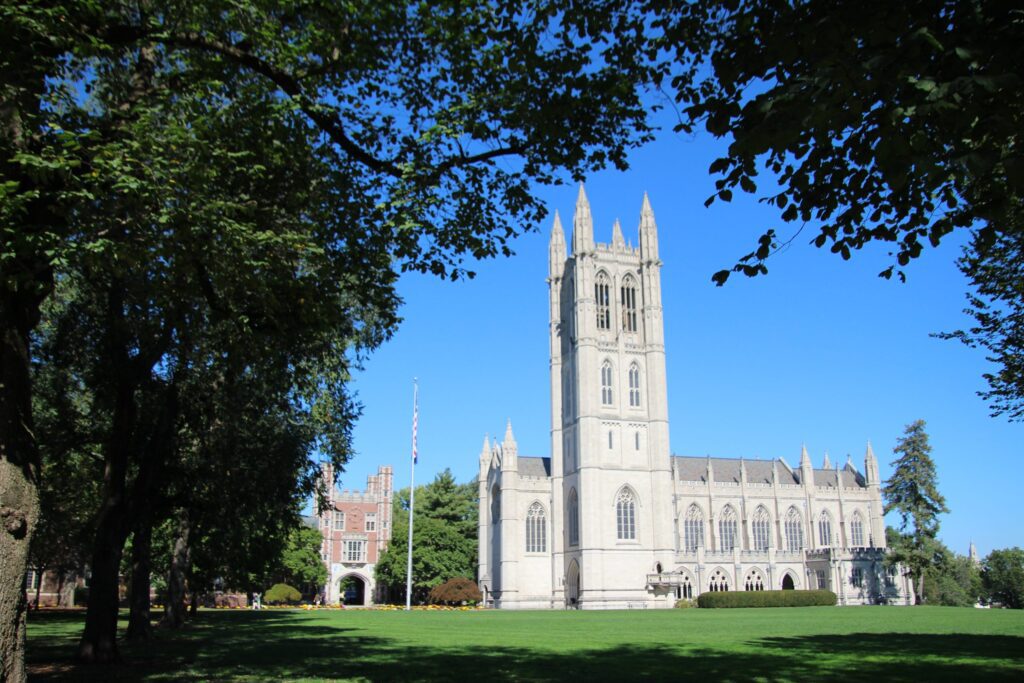
The Chapel (Photo credit: Sajja Ranjit ’29)
Iqra Athar ’26
Executive News Editor
Trinity College earned broad national recognition this fall with the new rankings highlighting both academic reputation and career outcomes. Most notably, LinkedIn placed Trinity at number four among U.S. liberal arts colleges and 42nd overall in its first Top Colleges ranking, which evaluates long-term career outcomes using job placement, recruiter demand, alumni network strength and knowledge breadth. The result positions Trinity near the top of NESCAC peers on career outcomes.
U.S. News & World Report ranked Trinity 37th among national liberal arts colleges, 39th for “best value” and 60th in undergraduate engineering (non-doctoral). Trinity was also recognized in psychology and economics among national programs. In other lists that emphasize return on investment, Forbes ranked Trinity 88nd in “America’s Top Colleges,” while The Princeton Review listed Trinity among its “Top 50 Best Value Colleges (Private Schools).”
Internal outcomes data reinforce those external signals. The Career and Life Design Center reports that 95.2% of the Class of 2024 secured employment, graduate study, service or military roles within six months. Graduates entered finance, STEM and health fields in large numbers, with additional placements in public policy, education, nonprofits, communications and the arts.
At the same time, rankings that foreground access and affordability point to persistent tradeoffs at high-price liberal arts colleges. Money, a magazine focusing on financial aspects of college education, recognized Trinity for value, estimating an average post-aid price of about $33,800 and an 86% graduation rate. Washington Monthly placed Trinity 57th among liberal arts colleges, rewarding institutions that expand access and public service alongside traditional outcomes. In a Tripod communication over email, Vice President for Strategic Marketing and Communications Hellen Hom-Diamond explained that while “standards and methodologies can change from year to year,” Trinity’s goal is to “consider the full picture of where we did well, because it’s a compelling story.” She added that rankings “don’t guide policymaking,” noting that the College’s financial aid office “works hard to ensure that Trinity offers robust and generous financial aid.” As federal rules and borrowing caps shift, affordability remains a central question for families and for Connecticut colleges competing in a tight market.
Additionally, The Foundation for Individual Rights and Expression (FIRE) ranked Trinity #181 of 257 in its 2026 College Free Speech Rankings and assigned an overall F for speech climate, alongside a “yellow light” policy rating. Critics argue that the ranking leans on contested measures and underweights local context. In an interview with the Tripod, Political Science Professor Isaac Kamola called the rankings “garbage” and said they privilege adoption of the Chicago Principles—a 2015 free speech framework developed by University of Chicago—over “actual campus dynamics.” He argued the metrics “fit into a political narrative” and can reward institutions that “discipline their own students for speech” while scoring well on paper. Notably, recently hired Visiting Lecturer in Formal Organizations Adam Kissel previously served as FIRE’s director of the Individual Rights Defense Program.
Hom-Diamond and Associate Vice President of External Affairs Jason Rojas, in response to Tripod questions over email, acknowledged that “the FIRE rankings this year were probably more indicative of the overall climate and a more complex time when pressures have been both internal and external.” They added that the College “is looking at ways to engage the community in productive conversations about shared values and to affirm the values that we as a community should uphold.”
The FIRE debate (methodologically disputed or not) intersects with policy shifts on many campuses. At Trinity, a newly adopted policy on demonstrations and protests aims to clarify time, place and manner guidelines while maintaining safety. Coupled with a low FIRE score, the policy raises a core question for students and faculty about how free speech is measured and whose standards define it in a polarized environment. In FIRE’s 2026 rankings, Claremont McKenna College topped the list with a score of 80 and B- grade, while institutions such as Barnard College and Columbia University landed at the bottom with failing grades.
As rankings proliferate, each using different yardsticks, they collectively paint a nuanced picture. Trinity performs competitively on career and value indicators but faces continuing questions about affordability and campus climate.

